Why Home Funerals Keeping the Body Cool is Becoming a Meaningful Choice
Home funerals keeping the body cool is a practice that allows families to care for their loved ones at home for 3-5 days while maintaining dignity and safety. Here's what you need to know:
Quick Answer for Home Funerals Keeping the Body Cool:
- Timing: Start cooling within 4-6 hours after death
- Methods: Air conditioning, dry ice (16 lbs/day), or polymer refrigerants like Techni-Ice
- Duration: 3-5 days safely with proper cooling techniques
- Temperature: Maintain 33-40°F to slow decomposition
- Legal: Check state requirements - most allow home funerals with proper permits
More families are choosing home funerals as a way to create meaningful closure while saving thousands compared to traditional funeral homes. The practice was actually the norm before modern funeral homes existed - families have always cared for their own dead.
The key challenge is keeping the body cool enough to slow decomposition without embalming. This requires understanding basic cooling methods, having the right supplies, and following safety protocols.
As Mortuary Cooler with years of experience in mortuary refrigeration systems, I've helped countless funeral directors understand effective body cooling methods for both professional and home settings. My expertise in home funerals keeping the body cool comes from working directly with families and funeral professionals who need reliable, practical cooling solutions.
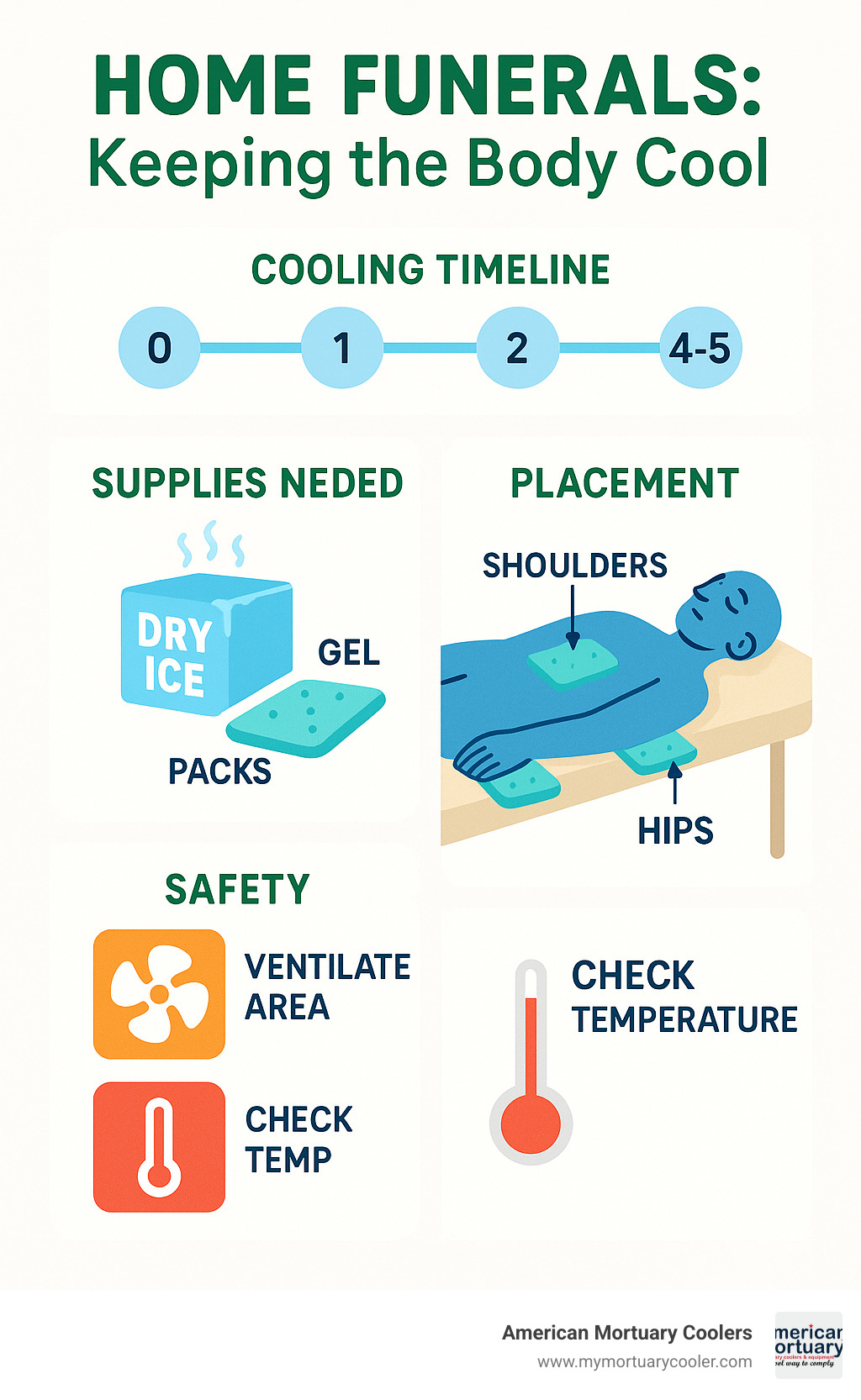
Easy home funerals keeping the body cool word list:
Why Cooling Matters: The Science & Benefits
Let's talk about what actually happens when someone dies and why home funerals keeping the body cool makes such a difference. It's not complicated science, but understanding it helps you feel confident about caring for your loved one at home.
When death occurs, the body's normal temperature of 98.6°F starts dropping right away. But here's the thing - decomposition begins immediately too. The bacteria that naturally live in our bodies don't just disappear. Without circulation to keep things in balance, they start breaking down tissues.
This is where cooling becomes your best friend. By keeping the body between 33-40°F, you're essentially hitting the pause button on decomposition. It's like putting food in the refrigerator - same principle, just more meaningful.
Rigor mortis is another piece of the puzzle. It typically starts 2-7 hours after death, making the body stiff, then relaxes again within 36-72 hours. During this entire process, proper cooling prevents odors, helps maintain a peaceful appearance, and keeps everyone safe during the vigil.
According to scientific research on body temperature after death, families can safely maintain a body at home for 3-5 days with the right cooling methods. That's much longer than the 24-hour limit many people think applies - and it gives you real time to grieve and make thoughtful arrangements.
The benefits go way beyond just buying time though. Proper cooling helps prevent infection risks, gives families control over the process, and creates space for the kind of goodbye that feels right for your family.
Grief-Healing Through Hands-On Care
Something beautiful happens when families choose home funerals keeping the body cool - they often experience deeper healing than they expected. There's something powerful about the hands-on care: gently bathing your loved one, choosing their clothes, arranging flowers around them.
This therapeutic touch isn't just busy work. It helps with acceptance in a way that sitting in a funeral home parlor simply can't match. Many families tell us they felt a sense of completion they never experienced with traditional services.
Children who participate in age-appropriate tasks often show remarkable resilience. They're less afraid of death and carry less guilt as they grow up. When death isn't hidden away but handled with love and care, it becomes less frightening and more natural.
The intimate home setting opens up space for storytelling, sharing memories, and creating a farewell that truly reflects who your loved one was. No rushing, no artificial timeline - just your family, your traditions, and your way of saying goodbye.
Environmental & Financial Upsides
Home funerals keeping the body cool offers some impressive environmental benefits that many families don't initially consider. Traditional funeral homes generate about two large garbage bags worth of disposable waste per body. Home care? Almost none.
Skip the embalming chemicals that eventually seep into groundwater. Avoid the emissions from industrial cremation processes. Many families pair home funerals with green burial practices, creating an end-of-life choice that honors both their loved one and the earth.
The financial savings are significant too. While funeral home services often run $8,000 or more, home care typically costs under $500 total. You're paying for basic supplies, permits, and maybe some equipment rental - not fancy facilities and overhead you don't need.
These aren't just nice side benefits. For many families, the environmental and financial advantages make home funerals keeping the body cool possible when traditional services would create hardship or go against their values.
Essential Supplies & Set-Up for Home Funerals Keeping the Body Cool
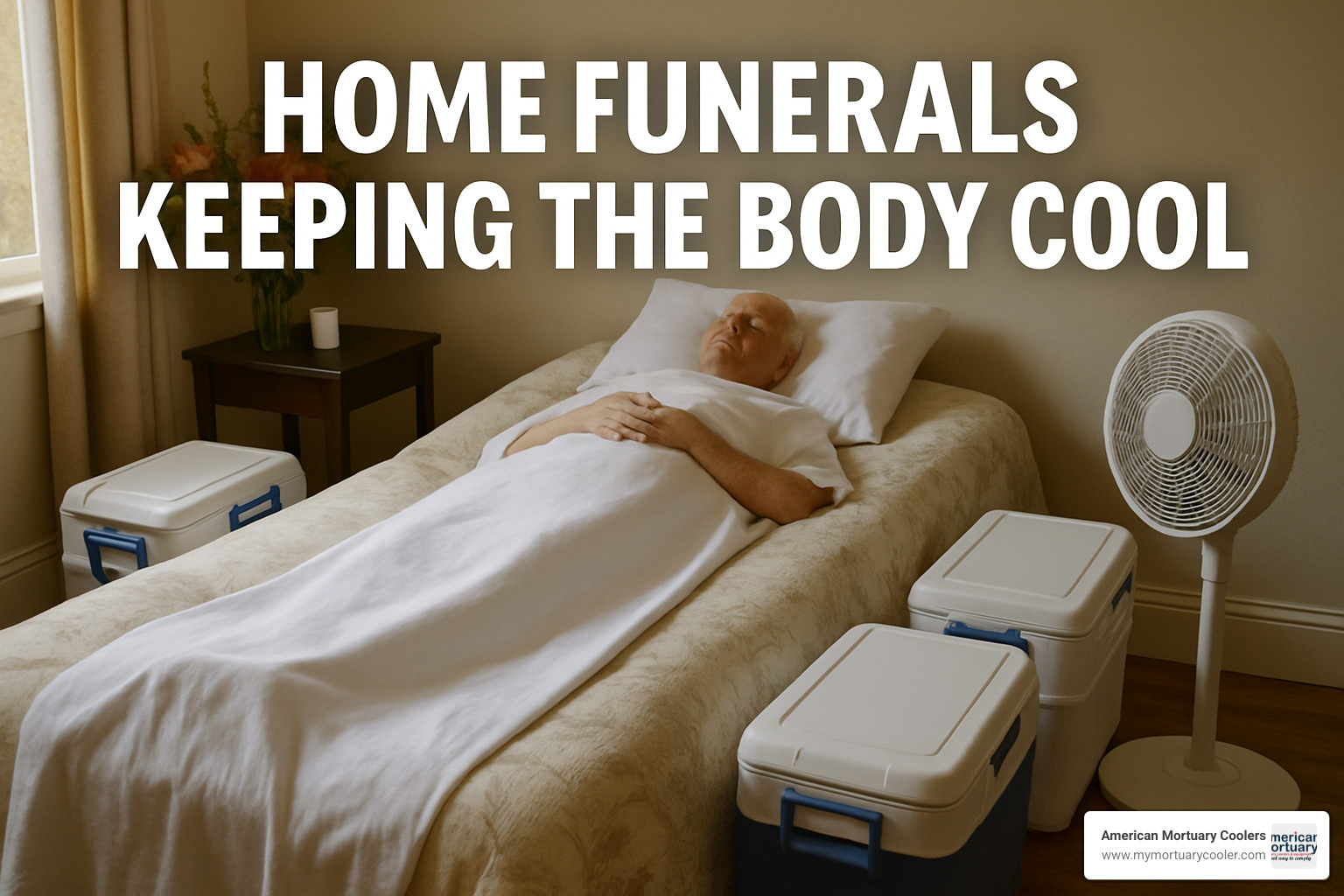
Success with home funerals keeping the body cool depends on having the right supplies ready before you need them. We recommend preparing these items in advance:
Must-Have Cooling Supplies:
- Dry ice (30 lbs initially, then 10-20 lbs daily)
- Polymer refrigerants like Techni-Ice (12 sheets)
- Reusable gel packs (6-8 large packs)
- Heavy-duty gloves for handling dry ice
- Digital thermometer
- Styrofoam cooler for dry ice storage
- Pillowcases or cloth bags for wrapping coolants
- Plastic sheeting or shower curtain for moisture barrier
- Foam padding (2-3 inches thick)
Room Preparation Items:
- Fans or portable air conditioning unit
- Extension cords if needed
- Towels and absorbent pads
- Basic cleaning supplies
- Comfortable seating for vigil
For more specialized equipment, check out More info about body chillers to understand professional-grade options that some families rent.
Choosing the Right Cooling Agent
Different cooling methods work better for different situations. Here's our comparison of the most effective options for home funerals keeping the body cool:
Dry Ice:
- Cost: About $1 per pound
- Duration: 24 hours per application
- Pros: Very effective, widely available
- Cons: Requires ventilation, can cause frostbite
- Best for: Multi-day vigils, experienced handlers
Polymer Refrigerants (Techni-Ice):
- Cost: $35 for 12 sheets
- Duration: 3-4 hours when activated
- Pros: Reusable, safer to handle, no off-gassing
- Cons: Shorter duration, requires freezer access
- Best for: Shorter vigils, families with children
Gel Packs:
- Cost: Varies, often available at home
- Duration: 6-8 hours
- Pros: Safe, easy to use, household item
- Cons: Limited cooling power
- Best for: Emergency backup, mild weather
Cryopak Blankets:
- Cost: Higher initial investment
- Duration: Extended periods
- Pros: Professional-grade, very safe
- Cons: Must be ordered in advance
- Best for: Planned home funerals
Preparing the Space
The room where you'll hold your vigil needs specific preparation for successful home funerals keeping the body cool. Choose the coolest room in your home, ideally on the north side away from direct sunlight.
Turn off heating in that room and use air conditioning or fans to maintain ambient temperatures below 65°F when possible. This reduces the amount of cooling agents needed and extends their effectiveness.
Lay plastic sheeting or a shower curtain under the body to protect furniture and flooring from condensation. Place thick foam padding on top to provide insulation between cooling materials and the body.
Ensure good ventilation, especially if using dry ice, by cracking windows or running exhaust fans. Poor ventilation can lead to dangerous CO₂ buildup in enclosed spaces.
Step-by-Step Methods: Home Funerals Keeping the Body Cool for 1–5 Days
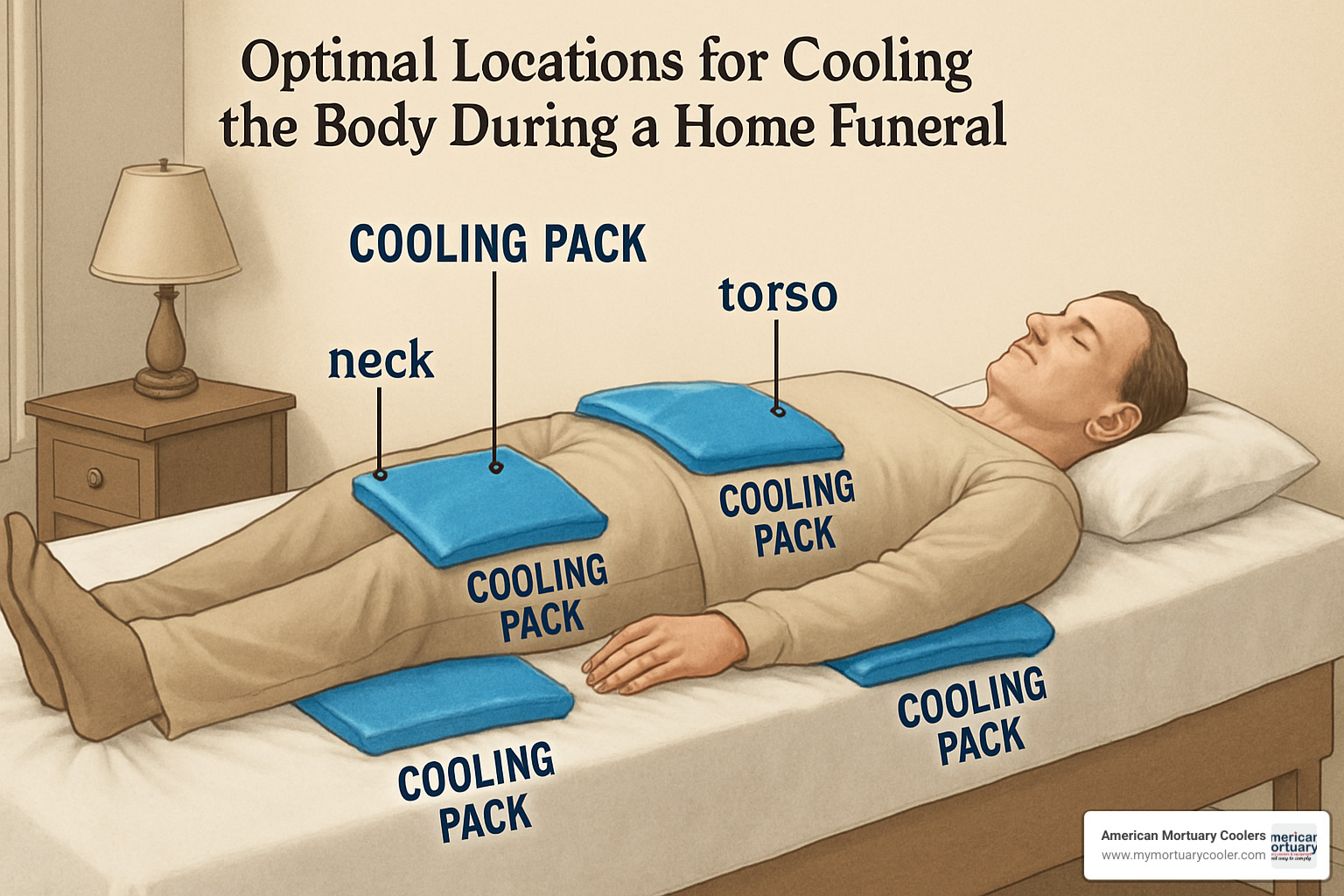
The most important thing to remember about home funerals keeping the body cool is timing - you need to start within those first 4-6 hours after death. This isn't meant to scare you, but rather to help you succeed in creating the peaceful vigil your family deserves.
Think of it like preparing a special meal - having everything ready beforehand makes the actual process much smoother. Your loved one has already been positioned on the foam padding with protective plastic underneath, and you've gathered all your cooling supplies.
The placement strategy is surprisingly simple. Focus on the major heat points: under each shoulder blade, the lower back and hip area, and initially under the head and lower abdomen. The key is never letting cooling materials touch skin directly - always wrap them in pillowcases or towels first.
Following the detailed NHFA guide will give you comprehensive instructions, but what we're sharing here are the practical steps that actually work in real homes with real families.
0–24 Hours: Fast Start for "Home Funerals Keeping the Body Cool"
If your vigil will be shorter, you might breathe a sigh of relief knowing that home funerals keeping the body cool for just one day requires much less intensive methods. Your air conditioning and some frozen gel packs can handle most of the work.
Start with about six frozen gel packs wrapped in pillowcases. Place them at those key body points we mentioned earlier. During the first day, you'll want to replace these every 3-4 hours, then you can relax the schedule to every 8-10 hours afterward.
Temperature monitoring becomes your new routine, but don't stress about it. You're aiming for around 47-48°F as many states require, but the real goal is avoiding skin freezing by rotating those cooling materials regularly.
Keep a simple notebook nearby to jot down what you're using and when you change materials. During such an emotional time, it's easy to forget when you last checked things, and staying organized helps everything go smoothly.
24–72 Hours: Dry Ice & Techni-Ice Routine
Here's where home funerals keeping the body cool gets more serious, but don't worry - thousands of families have done this successfully. For longer vigils, dry ice becomes your best friend, and you'll need about 16 pounds per day for an adult body.
Breaking dry ice feels a bit like a science experiment. Use a hammer and chisel to create 1-2 inch chunks, and always wear those heavy gloves - dry ice will give you frostbite faster than you'd expect. Place the pieces in paper bags or wrap them in towels before positioning them under the body.
That 2-3 inch foam pad between the body and dry ice isn't just for comfort - it prevents direct contact and actually makes your dry ice last longer by providing insulation. It's one of those simple tricks that makes a big difference.
You'll replace dry ice on top of the body daily, but the pieces underneath often last longer thanks to that insulation. Remember to crack a window or run a fan when working with larger amounts of dry ice - the CO₂ buildup can be dangerous in closed spaces.
Techni-Ice sheets work beautifully alongside dry ice, especially around the torso area. Soak them in water to activate, then freeze before use. Many families prefer these because they're much safer to handle than dry ice, especially when children are helping with the vigil.
Day 3–5: Extended Vigil & Backup Options
Extended home funerals keeping the body cool beyond three days requires some creative thinking, but it's absolutely doable. Some families have parked a refrigerated van in their garage, maintaining steady 40°F temperatures - it sounds unusual, but it works perfectly.
Professional mortuary cooling equipment becomes worth considering for longer vigils. Here at American Mortuary Coolers, we've helped many families access portable cooling units that simply plug into standard outlets and maintain precise temperatures without all the dry ice handling.
Your monitoring routine becomes even more important during extended vigils. Check the body more frequently and watch for any signs that your cooling isn't keeping up. Having a backup plan ready - including contact information for local funeral homes that can provide emergency refrigeration - gives you peace of mind.
The beautiful thing about longer vigils is they give families time to really process their grief and say proper goodbyes. With the right cooling methods, you can focus on what matters most - being together during this important time.
Monitoring, Safety & Legal Must-Knows
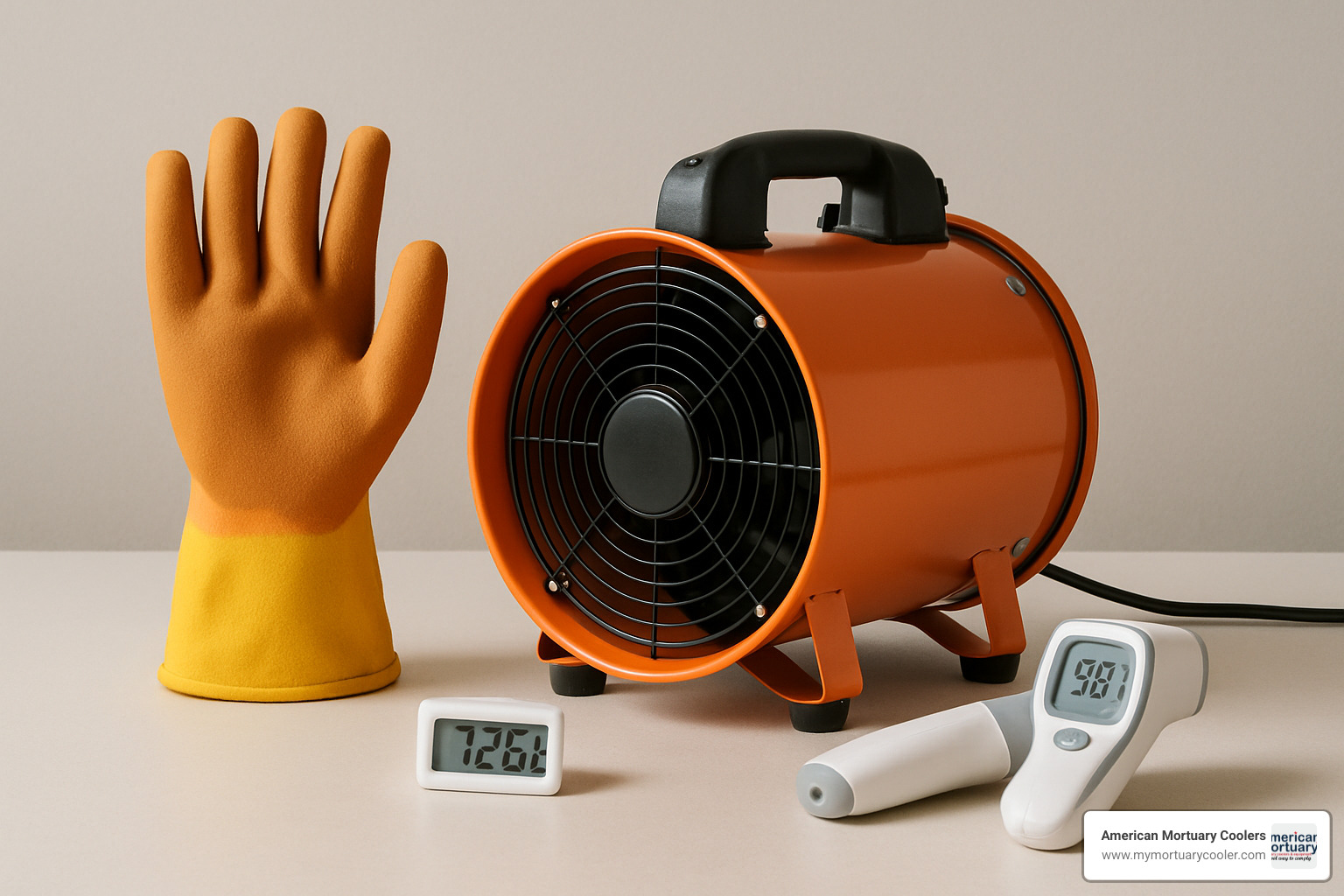
When you're managing home funerals keeping the body cool, safety isn't just important - it's absolutely critical for your family's wellbeing. The cooling methods that make home vigils possible also create risks that require your careful attention.
The biggest safety concern comes from dry ice, which releases carbon dioxide gas as it melts. This invisible gas can quickly build up in closed spaces and become dangerous. You'll know CO₂ levels are getting too high if anyone experiences headaches, dizziness, or confusion. These symptoms mean you need fresh air immediately.
Never use dry ice in a completely sealed room. Always keep windows cracked or fans running to move air around. When we work with families at American Mortuary Coolers, we always emphasize that good ventilation isn't optional - it's what keeps everyone safe during your vigil.
Physical safety matters just as much. Always wear thick, insulated gloves when handling dry ice - it's cold enough to cause frostbite in seconds. Use tongs or scoops instead of your hands, even with gloves on. Keep dry ice completely away from children and pets, and never store it in airtight containers that could build up dangerous pressure.
The legal side of home funerals keeping the body cool varies significantly depending on where you live. Most states welcome families who want to care for their loved ones at home, but nine states require some level of funeral director involvement. Our state requirements guide breaks down exactly what's allowed in your area.
Generally, you'll need to file the death certificate within 24 to 48 hours and get proper permits if you're transporting the body yourself. Some states require bodies to be cooled to specific temperatures - usually around 40°F - if you're not using embalming. These aren't arbitrary rules; they're designed to protect public health while honoring your right to care for family.
Signs Cooling Isn't Enough
Even with the best planning, sometimes your cooling methods need adjustment. Recognizing the warning signs early helps you respond quickly and keep your vigil on track.
Unusual odors are often the first sign that your home funerals keeping the body cool approach needs more intensive methods. A slight medicinal smell is normal, but strong or unpleasant odors mean you need more cooling power immediately.
Watch for skin discoloration beyond normal settling. Some color changes are expected as blood settles, but dramatic changes or unusual patterns suggest inadequate cooling. Similarly, any purge fluids from the mouth or nose indicate that decomposition is progressing faster than your cooling can control.
Body temperature rising above 45°F is a clear signal to add more cooling materials or switch to more powerful methods like dry ice. Check temperatures regularly with a digital thermometer - it's much more reliable than guessing.
If you notice any of these signs, don't panic. Even experienced funeral directors sometimes need to adjust their approach. Increase your cooling immediately, improve ventilation, and don't hesitate to contact a funeral home for additional equipment if needed.
Adjusting Plans: Burial vs. Cremation Differences
Your final plans affect how you approach home funerals keeping the body cool. Different disposition methods have different requirements that impact your timeline and preparation.
Cremation requires specific preparation that burial doesn't. You'll need to remove any pacemakers or battery-powered medical implants before the vigil begins - these can be dangerous in cremation chambers. Many states also require a 24 to 48-hour waiting period before cremation, which actually works in your favor for home vigils.
Call your chosen crematory ahead of time to confirm they accept family-prepared bodies. Most do, but it's better to know their policies before you need them.
Burial planning focuses more on timing and cemetery policies. Some cemeteries have specific requirements about family-prepared bodies, while others welcome green burial practices. Remove all cooling materials before burial - dry ice will dissipate naturally, but gel packs and other materials need to come home with you.
Cultural and religious considerations can significantly impact your approach. Some traditions require burial within 24 hours, which means your cooling needs are minimal. Others forbid embalming entirely, making home cooling not just preferred but necessary.
Jewish, Muslim, Hindu, and Bahá'í traditions often emphasize quick burial, while many Christian denominations are comfortable with longer vigil periods. Work with your religious leaders to ensure your home funerals keeping the body cool practices honor both safety requirements and spiritual beliefs.
The key is planning ahead and understanding that every family's situation is unique. What works perfectly for one vigil might need adjustment for another, and that's completely normal.
Frequently Asked Questions about Cooling a Body at Home
Families considering home funerals keeping the body cool often have similar concerns about safety, timing, and practical challenges. Let me address the most common questions we hear from families across the country.
How long can we safely keep the body at home?
The honest answer is that with proper home funerals keeping the body cool techniques, most families can safely maintain their loved one at home for 3-5 days. This timeframe works well for most family situations and allows enough time for relatives to travel and participate in the vigil.
The success depends on several key factors working together. You'll need to start your cooling process within those critical first 4-6 hours after death - this timing makes all the difference in maintaining appearance and preventing complications.
Temperature control is your most important job. Keep the body between 33-40°F consistently throughout the vigil period. This usually means using about 16 pounds of dry ice daily, or equivalent cooling with polymer refrigerants and gel packs.
Some families have successfully extended their vigil to a full week using professional-grade cooling equipment, but we generally recommend the 3-5 day window for most home situations. It's better to have a meaningful, safe experience than to push beyond your comfort zone or available resources.
Is dry ice dangerous inside a small room?
This is probably the safety question we get asked most often, and it's a smart concern. Dry ice can be dangerous in poorly ventilated spaces because it releases carbon dioxide gas as it melts away. The CO₂ can build up and displace oxygen, which creates serious health risks.
For safe home funerals keeping the body cool with dry ice, ventilation is absolutely essential. Never use dry ice in completely sealed rooms - always crack windows or run exhaust fans to keep air moving. We recommend using smaller amounts more frequently rather than placing large blocks all at once.
Watch for warning symptoms of CO₂ buildup: headaches, dizziness, or rapid breathing. If anyone experiences these symptoms, get fresh air immediately and increase ventilation in the vigil space.
Keep your dry ice storage containers slightly open to allow gas to escape safely. Never store dry ice in completely airtight containers, as pressure buildup can cause containers to burst.
If your vigil space is very small - under 100 square feet - consider using gel packs or Techni-Ice instead of dry ice. These alternatives don't release gases and are much safer for confined spaces, though they require more frequent changing.
Do cooling requirements change in summer or humid climates?
Weather conditions absolutely affect your cooling needs for home funerals keeping the body cool. Hot, humid weather creates bigger challenges and requires adjusting your approach significantly.
During summer months, you'll likely need 20-25 pounds of dry ice daily instead of the standard 16 pounds. The heat works against your cooling efforts constantly, so you'll also need to change cooling materials more frequently - sometimes every 4-6 hours instead of the usual 8-12 hour intervals.
High humidity creates its own problems beyond just heat. Condensation becomes a bigger issue, making moisture barriers under the body even more important. You might need extra towels and absorbent pads to manage the additional moisture.
Air conditioning becomes essential rather than just helpful during hot weather. Even with adequate cooling materials, ambient room temperature above 75°F makes your job much harder and uses up cooling agents faster.
Winter conditions work in your favor. Some families successfully use only air conditioning and gel packs during cold weather, especially if they can maintain room temperatures below 60°F consistently.
Regional differences matter too. Desert climates with low humidity are easier to manage than tropical climates with high humidity, even at similar temperatures. Plan accordingly based on your local weather patterns.
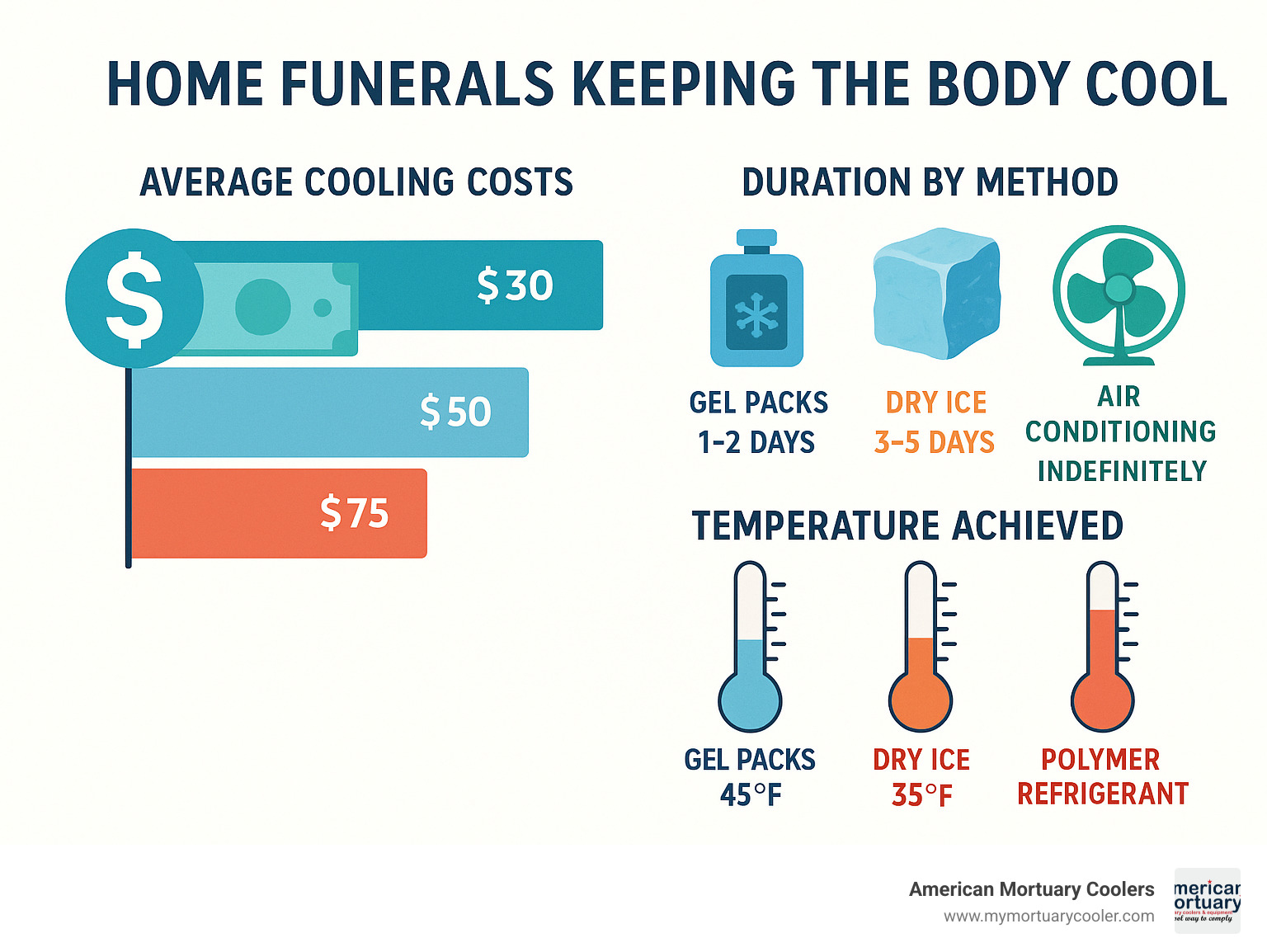
Conclusion & Next Steps
Caring for your loved one at home through home funerals keeping the body cool creates a deeply personal farewell that honors both your family's needs and ancient traditions. You've learned that with the right preparation and supplies, most families can safely maintain a body at home for 3-5 days while saving thousands of dollars and reducing environmental impact.
The journey starts with understanding the essentials: beginning cooling within those critical first 4-6 hours, choosing the right cooling method for your situation, and maintaining proper safety protocols throughout your vigil. Whether you use dry ice, polymer refrigerants like Techni-Ice, or professional equipment, success comes from preparation and having backup plans ready.
You're not alone in this process. The National Home Funeral Alliance provides excellent resources and support for families choosing this meaningful path. Local home funeral guides can walk you through your state's specific requirements and help you feel confident in your preparations.
Some families need more than DIY solutions, especially for extended vigils or challenging summer conditions. That's where professional-grade cooling equipment makes the difference between stress and peace of mind. At American Mortuary Coolers, we've helped countless families access portable cooling units that plug into standard outlets and maintain precise temperatures - no guesswork required.
Our custom mortuary coolers can be adapted specifically for home use, providing the same reliable temperature control that funeral homes depend on. We deliver directly across the contiguous 48 states, so whether you're in rural Tennessee or urban California, professional cooling support is available.
The beauty of home funerals keeping the body cool lies in the flexibility to create exactly the farewell your family needs. Some families combine our professional cooling equipment with traditional vigil practices. Others use our solutions as backup support while primarily relying on dry ice methods. There's no single "right" way - only what works best for your situation.
Even if you're just beginning to consider this option, taking small steps now helps later. Review your state's requirements, connect with local resources, and consider what supplies or equipment might serve your family best when the time comes.
The goal isn't perfection - it's creating a safe, dignified space where your family can process grief, share memories, and say goodbye in your own way. Whether that means three days with gel packs or a week with professional cooling equipment, the choice is yours to make.
For families ready to explore professional cooling solutions that can support your home funeral plans, visit More info about body cooling systems to find options that provide confidence and peace of mind during this sacred time.


















